HUMANISE: Human-Inspired Smart Management, towards a Healthy and Safe Industrial Collaborative Robotics
Abstract
1. Introduction
2. Collaborative Robot (Cobot) in Industrial Environments
3. Materials and Methods
3.1. Materials
- UC1-Coordination: this is the previously described real task, Cobot LfD (Figure 3) for “collaborative parts transportation”.
- UC2-Stress: this was a simulated case of a stressed worker based on the visual feedback features of UC1. An algorithm generated this simulated case.
- UC3-High risk: this was a Cobot risk behaviour UC where the Cobots did not perform in a coordinated way, and there was high speed and accelerated misbehaviour. An algorithm generated this simulated case.
3.2. Methods
3.2.1. Overall Methodology and Framework
- Knowledge extraction: (i) Knowledge from the WHO health workplace models, (ii) Knowledge from the environmental activity data of the visual feedback provided by the perception system, (iii) Knowledge provided by the ML models.
- An intelligent agent to provide smart interactive support to a specialist who could interact and regulate the environment. The agent will be guided in a future design by means of human-brain patterns.
- Intelligent control and management of the Cobots by the regulation of both control algorithm parameters and trajectory coordination.
3.2.2. Smart Management System
- The intelligent management module: the core of this module consists of the WHO and visual environment ML models (Support Vector Machines, SVM), and an intelligent agent. This last component will manage the conditions of the workplace by sending instructions and information to the control module.
- The control module: This component adapts the Cobot behaviour and gives support to the workers for a successful and coordinated evolution of the task improving the quality of the process. This real-time control and support will be essential for health and safety work conditions.
- The perception encoder. This component manages in real-time the visual information that enriches the intelligent management module.
3.2.3. WHO Health Workplace Model
- Health and safety in the physical work environment.
- Health, safety, and well-being in the psychosocial work environment.
- Personal health resources in the workplace.
- Enterprise community resources.
3.2.4. Monitoring and Control of the Cobot Environment
- Monitoring: The monitoring of the activity areas is used as co-manipulation feedback and support for workers in risk.
- Intelligent risk management: Robot/Human (R/H) behaviour management, robot control and worker support.
- Cobot environment monitoring: the main information is provided as feedback.
- Data/image acquisition and pre-processing: acquisition, binarization and filtering for each frame, detection of activity areas and extraction of activity centroids for each area.
- Trajectory generation: (i) for monitoring, extraction of n regions of interest (ROIs) of the activity. (ii) for risk management, trajectory generation and trajectory feature extraction.
- Human/Robot (HR) risk detection: HR behaviour analysis and integration with the WHO models.
- Cobot environment intelligent management: intelligent management of the environment by the agent with information of the WHO models. Robot control by the information of coordination.
- Worker support: the system will provide support and also feedback by the monitoring system.
Data Acquisition and Pre-Processing
Feature Extraction: Trajectory Analysis
- Number of activity areas.
- Velocity, and speed (∆).
- Acceleration (∆∆).
HR Behaviour Modelling and Risk Management
- Support Vector Machines (SVM).
- Multilayer Perceptron (MLP) defined by L layers of N neurons and the Number of Neurons in Hidden Layers (NNHL): L = 1 and NNHL= (number of features + classes number)/2.
Intelligent Management of the Cobot Environment and Worker Support
3.2.5. System Evaluation
- Coordination Level (CL, 0–100%). Accuracy (%) has been used in order to evaluate the CL between centroids. On the one hand, a value close to 50 in Accuracy is associated to a similar behaviour of both centroids, and this means a coordinated behaviour. On the other hand, as long as the value increases or decreases the CL decreases.
- Risk Level (RL, 0–100%). RL = 100-CL. Then, when CL decreases RL increases and it needs to be regulated by the robot control system or by worker support.
- Model Time (MT): This is the time to build the model and it is oriented to real-time systems. This is a critical parameter for the system in this framework.
- ∆Risk Level: RL of the worker without HUMANISE management-Risk Level of the worker with HUMANISE management
3.2.6. Calibration
4. Results and Discussion
5. Conclusions
6. Ethics Statement
Author Contributions
Funding
Informed Consent Statement
Data Availability Statement
Acknowledgments
Conflicts of Interest
References
- Supporting Active Ageing before Retirement: A Systematic Review and Meta-Analysis of Workplace Physical Activity Interventions Targeting Older Employees|BMJ Open. Available online: https://bmjopen.bmj.com/content/11/6/e045818 (accessed on 7 January 2023).
- Healthy Workplaces: A Model for Action. Available online: https://www.who.int/publications-detail-redirect/healthy-workplaces-a-model-for-action (accessed on 7 January 2023).
- OSH Management in the Context of an Ageing Workforce|Safety and Health at Work EU-OSHA. Available online: https://osha.europa.eu/en/themes/osh-management-context-ageing-workforce (accessed on 7 January 2023).
- European Agency for Safety & Health at Work—Information, Statistics, Legislation and Risk Assessment Tools. Available online: https://osha.europa.eu/en (accessed on 7 January 2023).
- Chen, B.; Vondrick, C.; Lipson, H. Visual Behavior Modelling for Robotic Theory of Mind. Sci. Rep. 2021, 11, 424. [Google Scholar] [CrossRef]
- IFR Presents World Robotics Report 2020—International Federation of Robotics. Available online: https://ifr.org/ifr-press-releases/news/record-2.7-million-robots-work-in-factories-around-the-globe (accessed on 7 January 2023).
- Peters, B.S.; Armijo, P.R.; Krause, C.; Choudhury, S.A.; Oleynikov, D. Review of Emerging Surgical Robotic Technology. Surg. Endosc. 2018, 32, 1636–1655. [Google Scholar] [CrossRef] [PubMed]
- Riek, L.D. Healthcare Robotics. Commun. ACM 2017, 60, 68–78. [Google Scholar] [CrossRef]
- Duckett, T.; Pearson, S.; Blackmore, S.; Grieve, B.; Chen, W.-H.; Cielniak, G.; Cleaversmith, J.; Dai, J.; Davis, S.; Fox, C.; et al. Agricultural Robotics: The Future of Robotic Agriculture 2018. Available online: https://uwe-repository.worktribe.com/output/866226 (accessed on 18 January 2023).
- EUnited Robotics—European Robotics Association—European Robotics Industry. Available online: https://www.eu-nited.net/eunited+aisbl/robotics/eunited-robotics-european-robotics-association-.html (accessed on 7 January 2023).
- Vinanzi, S.; Cangelosi, A.; Goerick, C. The Collaborative Mind: Intention Reading and Trust in Human-Robot Interaction. iScience 2021, 24, 102130. [Google Scholar] [CrossRef] [PubMed]
- Xu, T.; Fan, J.; Chen, Y.; Ng, X.; Ang, M.H.; Fang, Q.; Zhu, Y.; Zhao, J. Dynamic Identification of the KUKA LBR Iiwa Robot with Retrieval of Physical Parameters Using Global Optimization. IEEE Access 2020, 8, 108018–108031. [Google Scholar] [CrossRef]
- Herrero, H.; Outón, J.L.; Puerto, M.; Sallé, D.; López de Ipiña, K. Enhanced Flexibility and Reusability through State Machine-Based Architectures for Multisensor Intelligent Robotics. Sensors 2017, 17, 1249. [Google Scholar] [CrossRef]
- Ibarguren, A.; Eimontaite, I.; Outón, J.L.; Fletcher, S. Dual Arm Co-Manipulation Architecture with Enhanced Human–Robot Communication for Large Part Manipulation. Sensors 2020, 20, 6151. [Google Scholar] [CrossRef]
- Ibarguren, A.; Daelman, P. Path Driven Dual Arm Mobile Co-Manipulation Architecture for Large Part Manipulation in Industrial Environments. Sensors 2021, 21, 6620. [Google Scholar] [CrossRef] [PubMed]
- Home. Available online: https://www.sherlock-project.eu/ (accessed on 7 January 2023).
- Djuric, A.M.; Urbanic, R.J.; Rickli, J.L. A Framework for Collaborative Robot (CoBot) Integration in Advanced Manufacturing Systems. SAE Int. J. Mater. Manuf. 2016, 9, 457–464. [Google Scholar] [CrossRef]
- Ajoudani, A.; Zanchettin, A.M.; Ivaldi, S.; Albu-Schäffer, A.; Kosuge, K.; Khatib, O. Progress and Prospects of the Human–Robot Collaboration. Auton Robot. 2018, 42, 957–975. [Google Scholar] [CrossRef]
- Villani, V.; Pini, F.; Leali, F.; Secchi, C. Survey on Human–Robot Collaboration in Industrial Settings: Safety, Intuitive Interfaces and Applications. Mechatronics 2018, 55, 248–266. [Google Scholar] [CrossRef]
- Franklin, C.S.; Dominguez, E.G.; Fryman, J.D.; Lewandowski, M.L. Collaborative robotics: New era of human-robot cooperation in the workplace. J. Safety Res. 2020, 74, 153–160. [Google Scholar] [CrossRef] [PubMed]
- RIA TR R15.606-2016—Technical Report—Industrial Robots and Robot Systems—Safety Requirements—Collaborative Robots. Available online: https://webstore.ansi.org/standards/ria/riatrr156062016 (accessed on 7 January 2023).
- Gualtieri, M.; Pas, A. ten; Platt, R. Pick and Place Without Geometric Object Models 2018. Available online: https://arxiv.org/abs/1707.05615 (accessed on 18 January 2023).
- Song, D.; Goldberg, K.Y. Approximate Algorithms for a Collaboratively Controlled Robotic Camera. IEEE Trans. Robot. 2007, 23, 1061–1070. [Google Scholar] [CrossRef]
- The Interdisciplinary Handbook of Perceptual Control Theory—1st Edition. Available online: https://www.elsevier.com/books/the-interdisciplinary-handbook-of-perceptual-control-theory/mansell/978-0-12-818948-1 (accessed on 7 January 2023).
- Lasota, P.A.; Fong, T.; Shah, J.A. A Survey of Methods for Safe Human-Robot Interaction. FNT Robot. 2017, 5, 261–349. [Google Scholar] [CrossRef]
- Kanno, T.; Nakata, K.; Furuta, K. A Method for Team Intention Inference. Int. J. Hum. Comput. Stud. 2003, 58, 393–413. [Google Scholar] [CrossRef]
- Choudhury, R.; Swamy, G.; Hadfield-Menell, D.; Dragan, A.D. On the Utility of Model Learning in HRI. In Proceedings of the 2019 14th ACM/IEEE International Conference on Human-Robot Interaction (HRI), Daegu, Korea, 11–14 March 2019; pp. 317–325. [Google Scholar]
- Kelley, R.; Wigand, L.; Hamilton, B.; Browne, K.; Nicolescu, M.; Nicolescu, M. Deep Networks for Predicting Human Intent with Respect to Objects. In Proceedings of the Proceedings of the Seventh Annual ACM/IEEE International Conference on Human-Robot Interaction, Association for Computing Machinery, New York, NY, USA, 5 March 2012; pp. 171–172. [Google Scholar]
- Pérez-D’Arpino, C.; Shah, J.A. Fast Target Prediction of Human Reaching Motion for Cooperative Human-Robot Manipulation Tasks Using Time Series Classification. In Proceedings of the 2015 IEEE International Conference on Robotics and Automation (ICRA), Seattle, WA, USA, 26–30 May 2015; pp. 6175–6182. [Google Scholar]
- Thompson, S.; Horiuchi, T.; Kagami, S. A Probabilistic Model of Human Motion and Navigation Intent for Mobile Robot Path Planning. In Proceedings of the 2009 4th International Conference on Autonomous Robots and Agents, Wellington, New Zealand, 10–12 February 2009; pp. 663–668. [Google Scholar]
- Luber, M.; Stork, J.A.; Tipaldi, G.D.; Arras, K.O. People Tracking with Human Motion Predictions from Social Forces. In Proceedings of the 2010 IEEE International Conference on Robotics and Automation, Anchorage, AK, USA, 3–7 May 2010; pp. 464–469. [Google Scholar]
- Kumar, S.; Savur, C.; Sahin, F. Survey of Human–Robot Collaboration in Industrial Settings: Awareness, Intelligence, and Compliance. IEEE Trans. Syst. Man Cybern. Syst. 2021, 51, 280–297. [Google Scholar] [CrossRef]
- Marvel, J.A. Performance Metrics of Speed and Separation Monitoring in Shared Workspaces. IEEE Trans. Autom. Sci. Eng. 2013, 10, 405–414. [Google Scholar] [CrossRef]
- LBR Liwa. Available online: https://www.kuka.com/en-de/products/robot-systems/industrial-robots/lbr-iiwa (accessed on 7 January 2023).
- Calinon, S. Learning from Demonstration (Programming by Demonstration). In Encyclopedia of Robotics; Ang, M.H., Khatib, O., Siciliano, B., Eds.; Springer: Berlin/Heidelberg, Germany, 2018; pp. 1–8. ISBN 978-3-642-41610-1. [Google Scholar]
- Lopez-de-Ipina, K.; Solé-Casals, J.; Sánchez-Méndez, J.I.; Romero-Garcia, R.; Fernandez, E.; Requejo, C.; Poologaindran, A.; Faúndez-Zanuy, M.; Martí-Massó, J.F.; Bergareche, A.; et al. Analysis of Fine Motor Skills in Essential Tremor: Combining Neuroimaging and Handwriting Biomarkers for Early Management. Front. Hum. Neurosci. 2021, 15, 648573. [Google Scholar] [CrossRef]
- López-de-Ipiña, K.; Cepeda, H.; Requejo, C.; Fernandez, E.; Calvo, P.M.; Lafuente, J.V. Machine Learning Methods for Environmental-Enrichment-Related Variations in Behavioral Responses of Laboratory Rats. In Proceedings of the Understanding the Brain Function and Emotions; Ferrández Vicente, J.M., Álvarez-Sánchez, J.R., de la Paz López, F., Toledo Moreo, J., Adeli, H., Eds.; Springer International Publishing: Cham, Switzerland, 2019; pp. 420–427. [Google Scholar]
- Eguiraun, H.; López-de-Ipiña, K.; Martinez, I. Application of Entropy and Fractal Dimension Analyses to the Pattern Recognition of Contaminated Fish Responses in Aquaculture. Entropy 2014, 16, 6133–6151. [Google Scholar] [CrossRef]
- Requejo, C.; López-de-Ipiña, K.; Ruiz-Ortega, J.Á.; Fernández, E.; Calvo, P.M.; Morera-Herreras, T.; Miguelez, C.; Cardona-Grifoll, L.; Cepeda, H.; Ugedo, L.; et al. Changes in Day/Night Activity in the 6-OHDA-Induced Experimental Model of Parkinson’s Disease: Exploring Prodromal Biomarkers. Front. Neurosci. 2020, 14, 590029. [Google Scholar] [CrossRef]
- Tabianan, K.; Velu, S.; Ravi, V. K-Means Clustering Approach for Intelligent Customer Segmentation Using Customer Purchase Behavior Data. Sustainability 2022, 14, 7243. [Google Scholar] [CrossRef]
- Buerkle, A.; Matharu, H.; Al-Yacoub, A.; Lohse, N.; Bamber, T.; Ferreira, P. An Adaptive Human Sensor Framework for Human–Robot Collaboration. Int. J. Adv. Manuf. Technol. 2022, 119, 1233–1248. [Google Scholar] [CrossRef]
- Sazonov, E.; Hegde, N.; Browning, R.C.; Melanson, E.L.; Sazonova, N.A. Posture and Activity Recognition and Energy Expenditure Estimation in a Wearable Platform. IEEE J. Biomed. Health Inform. 2015, 19, 1339–1346. [Google Scholar] [CrossRef]
- Merry, K.J.; Macdonald, E.; MacPherson, M.; Aziz, O.; Park, E.; Ryan, M.; Sparrey, C.J. Classifying Sitting, Standing, and Walking Using Plantar Force Data. Med. Biol. Eng. Comput. 2021, 59, 257–270. [Google Scholar] [CrossRef]
- Jeong, G.-M.; Truong, P.H.; Choi, S.-I. Classification of Three Types of Walking Activities Regarding Stairs Using Plantar Pressure Sensors. IEEE Sens. J. 2017, 17, 2638–2639. [Google Scholar] [CrossRef]
- Liu, B.; Fu, W.; Wang, W.; Li, R.; Gao, Z.; Peng, L.; Du, H. Cobot Motion Planning Algorithm for Ensuring Human Safety Based on Behavioral Dynamics. Sensors 2022, 22, 4376. [Google Scholar] [CrossRef]
- Asaly, S.; Gottlieb, L.-A.; Inbar, N.; Reuveni, Y. Using Support Vector Machine (SVM) with GPS Ionospheric TEC Estimations to Potentially Predict Earthquake Events. Remote Sens. 2022, 14, 2822. [Google Scholar] [CrossRef]
- 14:00-17:00 ISO 10218-1:2011. Available online: https://www.iso.org/standard/51330.html (accessed on 7 January 2023).
- Martinetti, A.; Chemweno, P.K.; Nizamis, K.; Fosch-Villaronga, E. Redefining Safety in Light of Human-Robot Interaction: A Critical Review of Current Standards and Regulations. Front. Chem. Eng. 2021, 3. [Google Scholar] [CrossRef]
- Aswad, F.E.; Djogdom, G.V.T.; Otis, M.J.-D.; Ayena, J.C.; Meziane, R. Image Generation for 2D-CNN Using Time-Series Signal Features from Foot Gesture Applied to Select Cobot Operating Mode. Sensors 2021, 21, 5743. [Google Scholar] [CrossRef]
- Tuan, H.M.; Sanfilippo, F.; Hao, N.V. Modelling and Control of a 2-DOF Robot Arm with Elastic Joints for Safe Human-Robot Interaction. Front. Robot. AI 2021, 8, 223. [Google Scholar] [CrossRef]
- Bauer, A.; Wollherr, D.; Buss, M. Human–Robot Collaboration: A Survey. Int. J. Human. Robot. 2008, 05, 47–66. [Google Scholar] [CrossRef]
- Mokaram, S.; Aitken, J.M.; Martinez-Hernandez, U.; Eimontaite, I.; Cameron, D.; Rolph, J.; Gwilt, I.; McAree, O.; Law, J. A ROS-Integrated API for the KUKA LBR Iiwa Collaborative Robot**The Authors Acknowledge Support from the EPSRC Centre for Innovative Manufacturing in Intelligent Automation, in Undertaking This Research Work under Grant Reference Number EP/I033467/1, and the University of Sheffield Impact, Innovation and Knowledge Exchange Grant “Human Robot Interaction Development”. Equipment Has Been Provided under the EPSRC Great Technologies Capital Call: Robotics and Autonomous Systems. IFAC-PapersOnLine 2017, 50, 15859–15864. [Google Scholar] [CrossRef]
- Nagy, T.D.; Haidegger, T. Performance and Capability Assessment in Surgical Subtask Automation. Sensors 2022, 22, 2501. [Google Scholar] [CrossRef] [PubMed]
- Brito, T.; Queiroz, J.; Piardi, L.; Fernandes, L.A.; Lima, J.; Leitão, P. A Machine Learning Approach for Collaborative Robot Smart Manufacturing Inspection for Quality Control Systems. Procedia Manuf. 2020, 51, 11–18. [Google Scholar] [CrossRef]
- Czubenko, M.; Kowalczuk, Z. A Simple Neural Network for Collision Detection of Collaborative Robots. Sensors 2021, 21, 4235. [Google Scholar] [CrossRef]
- Khawaja, F.I.; Kanazawa, A.; Kinugawa, J.; Kosuge, K. A Human-Following Motion Planning and Control Scheme for Collaborative Robots Based on Human Motion Prediction. Sensors 2021, 21, 8229. [Google Scholar] [CrossRef]
- Kanazawa, A.; Kinugawa, J.; Kosuge, K. Adaptive Motion Planning for a Collaborative Robot Based on Prediction Uncertainty to Enhance Human Safety and Work Efficiency. IEEE Trans. Robot. 2019, 35, 817–832. [Google Scholar] [CrossRef]
- Safeea, M.; Neto, P.; Bearee, R. On-Line Collision Avoidance for Collaborative Robot Manipulators by Adjusting off-Line Generated Paths: An Industrial Use Case. Robot. Auton. Syst. 2019, 119, 278–288. [Google Scholar] [CrossRef]
- Pauliková, A.; Gyurák Babeľová, Z.; Ubárová, M. Analysis of the Impact of Human–Cobot Collaborative Manufacturing Implementation on the Occupational Health and Safety and the Quality Requirements. Int. J. Environ. Res. Public Health 2021, 18, 1927. [Google Scholar] [CrossRef]
- Gerloff, C.; Konrad, K.; Bzdok, D.; Büsing, C.; Reindl, V. Interacting Brains Revisited: A Cross-Brain Network Neuroscience Perspective. Hum. Brain Mapp. 2022, 43, 4458–4474. [Google Scholar] [CrossRef]
- Chen, P.-H.A.; Qu, Y. Taking a Computational Cultural Neuroscience Approach to Study Parent-Child Similarities in Diverse Cultural Contexts. Front. Hum. Neurosci. 2021, 15, 703999. [Google Scholar] [CrossRef] [PubMed]
- McDuff, D.; el Kaliouby, R.; Senechal, T.; Amr, M.; Cohn, J.F.; Picard, R. Affectiva-MIT Facial Expression Dataset (AM-FED): Naturalistic and Spontaneous Facial Expressions Collected “In-the-Wild”. In Proceedings of the 2013 IEEE Conference on Computer Vision and Pattern Recognition Workshops, Portland, OR, USA, 23–28 June 2013; pp. 881–888. [Google Scholar]
- Mollahosseini, A.; Hasani, B.; Mahoor, M.H. AffectNet: A Database for Facial Expression, Valence, and Arousal Computing in the Wild. IEEE Trans. Affect. Comput. 2019, 10, 18–31. [Google Scholar] [CrossRef]
- Jiang, Z.; Harati, S.; Crowell, A.; Mayberg, H.S.; Nemati, S.; Clifford, G.D. Classifying Major Depressive Disorder and Response to Deep Brain Stimulation Over Time by Analyzing Facial Expressions. IEEE Trans. Biomed. Eng. 2021, 68, 664–672. [Google Scholar] [CrossRef] [PubMed]
- What Is Universal Design|Centre for Excellence in Universal Design. Available online: https://universaldesign.ie/What-is-Universal-Design/ (accessed on 7 January 2023).
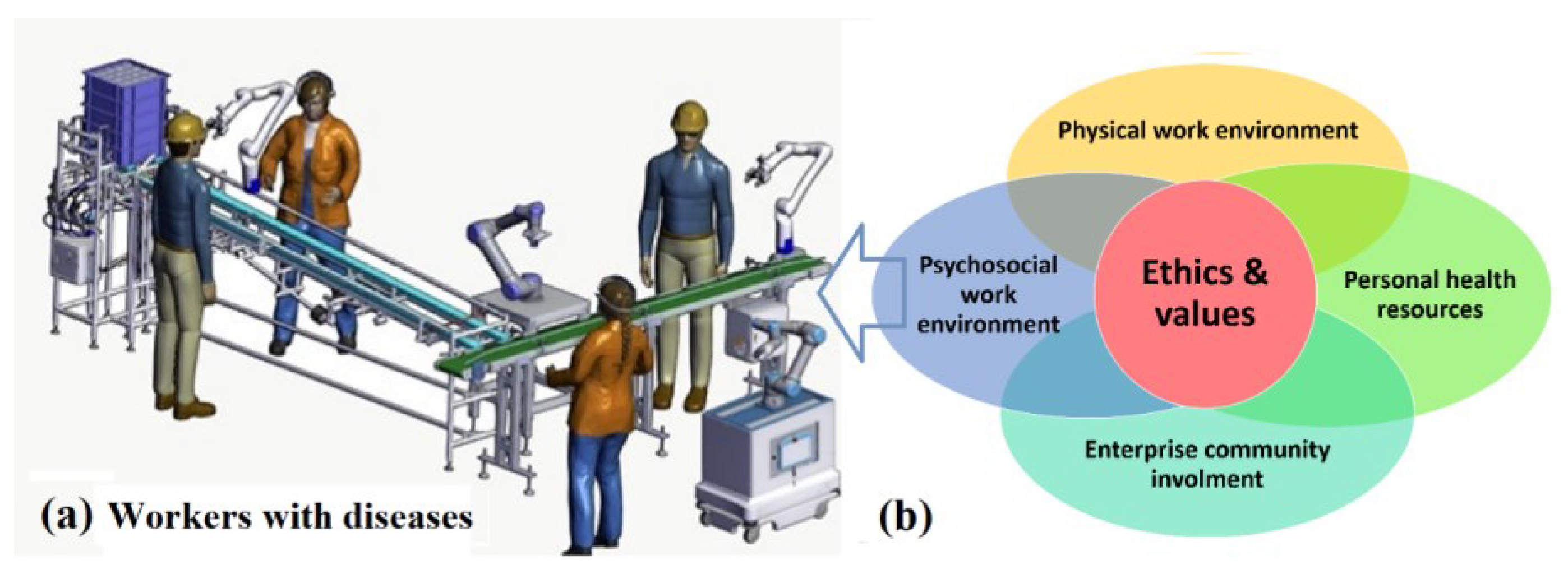


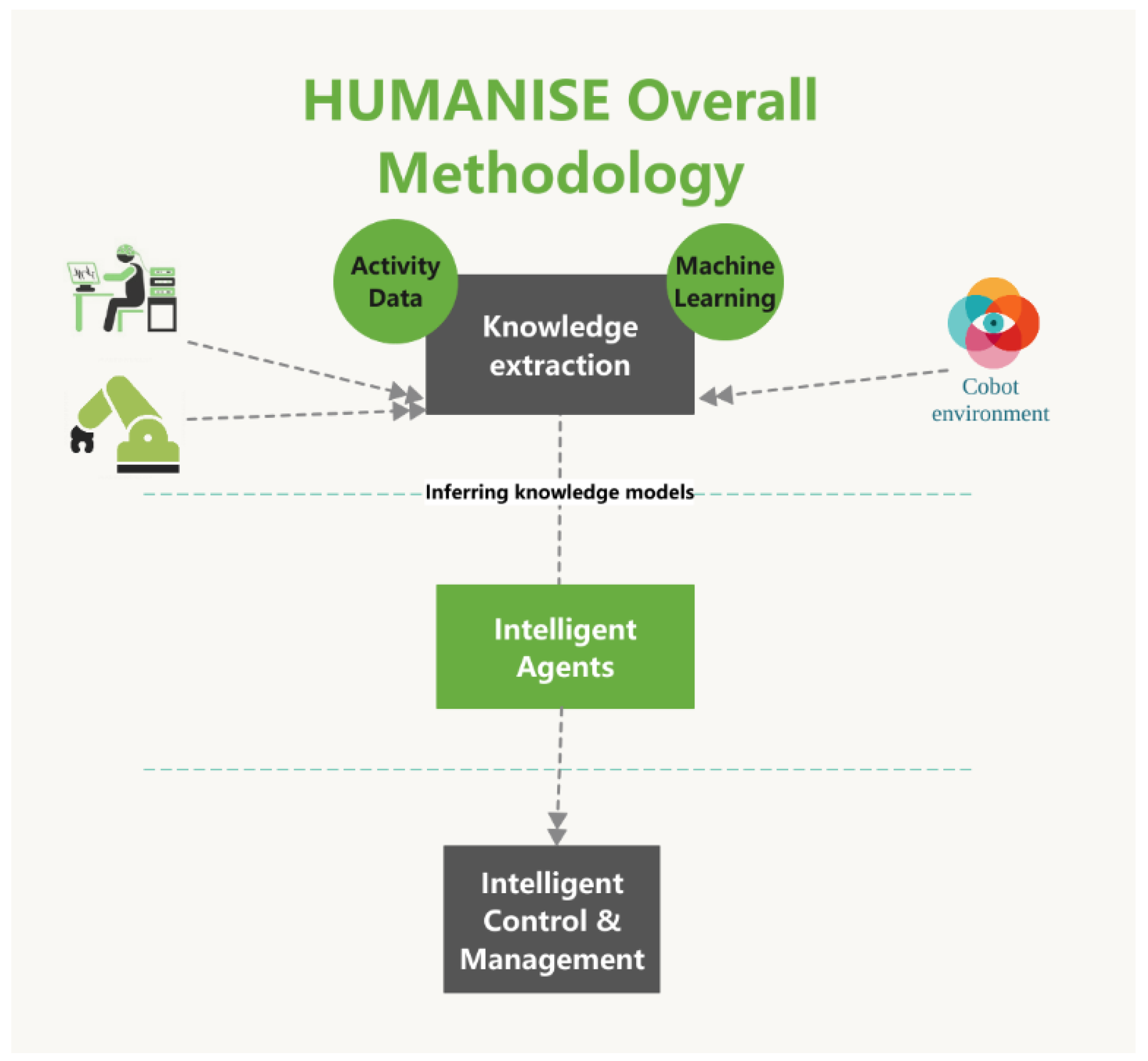
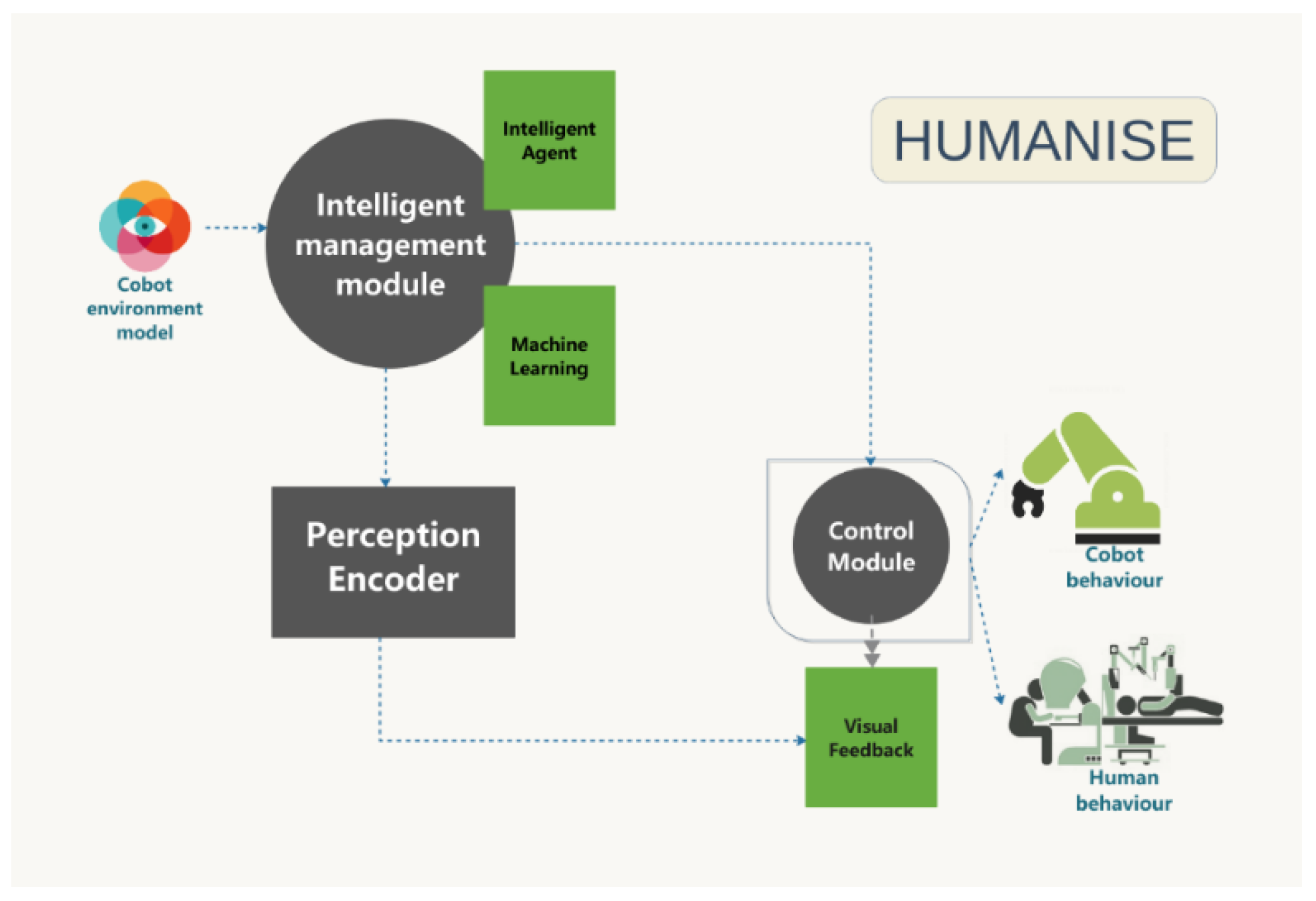






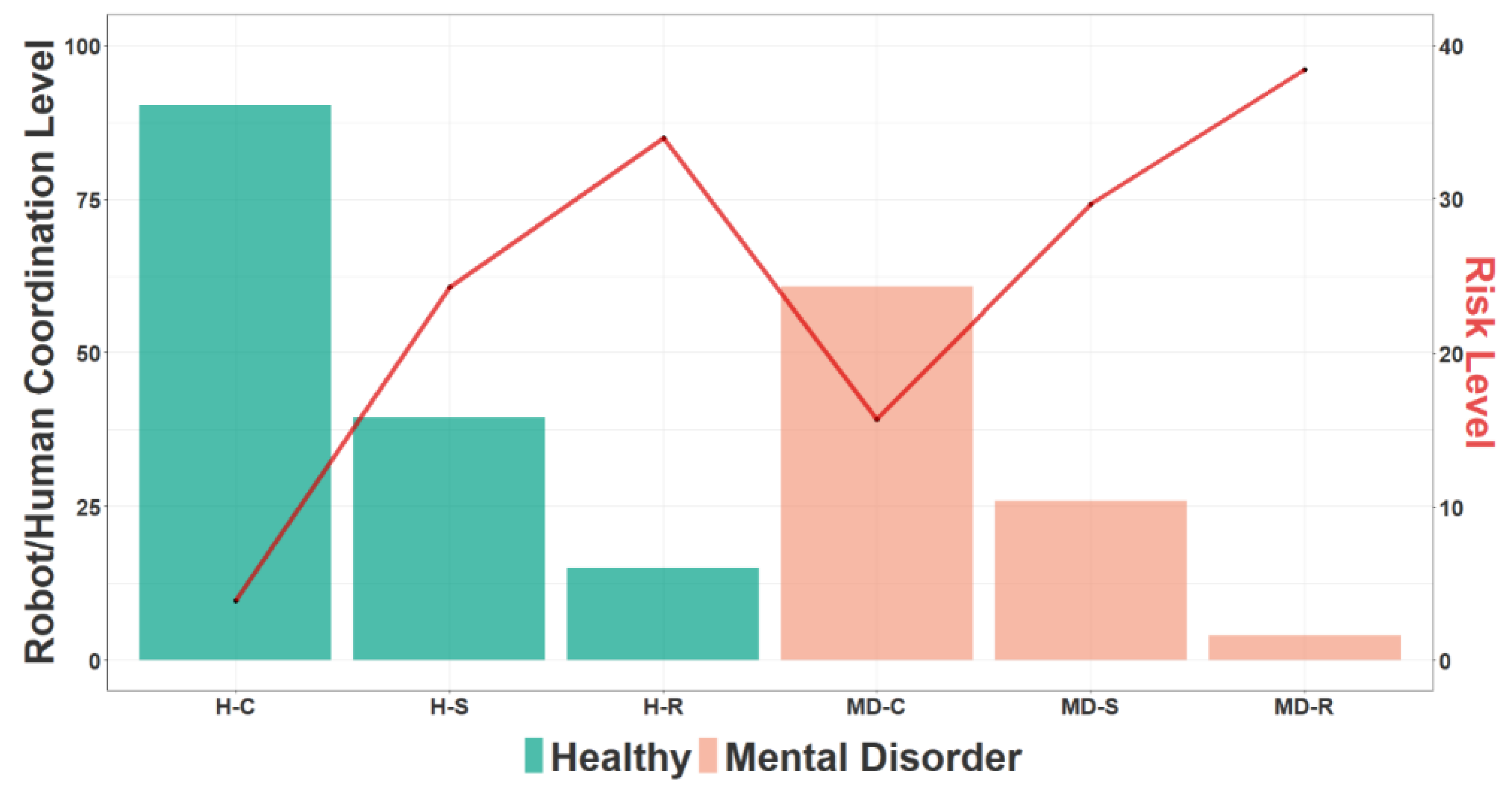
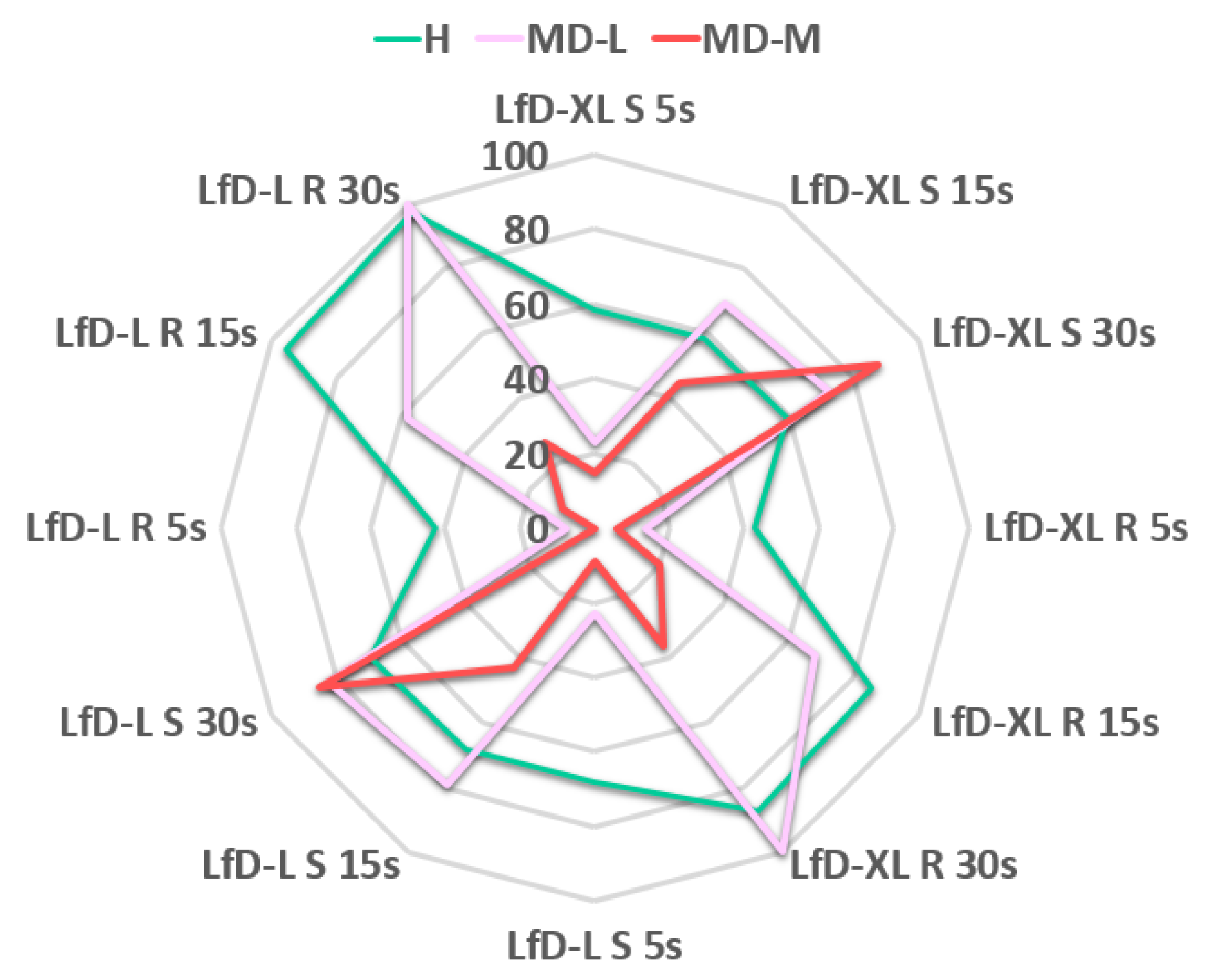
Disclaimer/Publisher’s Note: The statements, opinions and data contained in all publications are solely those of the individual author(s) and contributor(s) and not of MDPI and/or the editor(s). MDPI and/or the editor(s) disclaim responsibility for any injury to people or property resulting from any ideas, methods, instructions or products referred to in the content. |
© 2023 by the authors. Licensee MDPI, Basel, Switzerland. This article is an open access article distributed under the terms and conditions of the Creative Commons Attribution (CC BY) license (https://creativecommons.org/licenses/by/4.0/).
Share and Cite
Lopez-de-Ipina, K.; Iradi, J.; Fernandez, E.; Calvo, P.M.; Salle, D.; Poologaindran, A.; Villaverde, I.; Daelman, P.; Sanchez, E.; Requejo, C.; et al. HUMANISE: Human-Inspired Smart Management, towards a Healthy and Safe Industrial Collaborative Robotics. Sensors 2023, 23, 1170. https://doi.org/10.3390/s23031170
Lopez-de-Ipina K, Iradi J, Fernandez E, Calvo PM, Salle D, Poologaindran A, Villaverde I, Daelman P, Sanchez E, Requejo C, et al. HUMANISE: Human-Inspired Smart Management, towards a Healthy and Safe Industrial Collaborative Robotics. Sensors. 2023; 23(3):1170. https://doi.org/10.3390/s23031170
Chicago/Turabian StyleLopez-de-Ipina, Karmele, Jon Iradi, Elsa Fernandez, Pilar M. Calvo, Damien Salle, Anujan Poologaindran, Ivan Villaverde, Paul Daelman, Emilio Sanchez, Catalina Requejo, and et al. 2023. "HUMANISE: Human-Inspired Smart Management, towards a Healthy and Safe Industrial Collaborative Robotics" Sensors 23, no. 3: 1170. https://doi.org/10.3390/s23031170
APA StyleLopez-de-Ipina, K., Iradi, J., Fernandez, E., Calvo, P. M., Salle, D., Poologaindran, A., Villaverde, I., Daelman, P., Sanchez, E., Requejo, C., & Suckling, J. (2023). HUMANISE: Human-Inspired Smart Management, towards a Healthy and Safe Industrial Collaborative Robotics. Sensors, 23(3), 1170. https://doi.org/10.3390/s23031170





